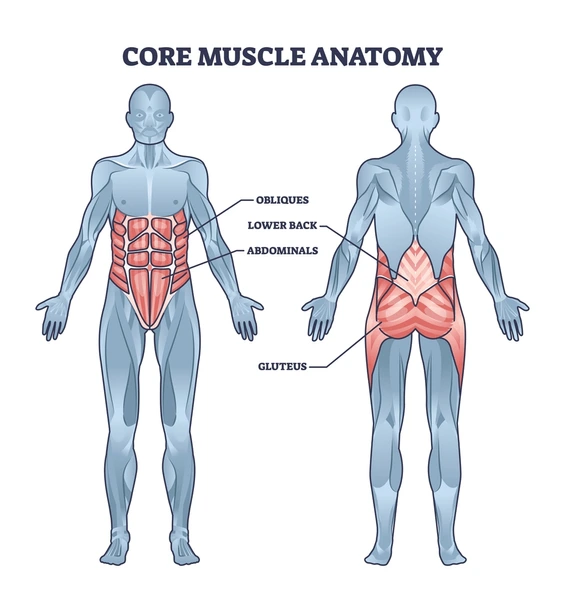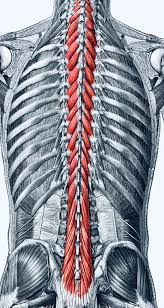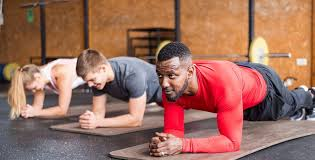Your Core
What is your Core?
The “core” is made up of your abs, hips, pelvis, and lower back. The purpose of your core is to improve stability, reduce risk of injury, and improve strength. Training the core is essential for overall health, functional fitness, and athletic performance.
Why Training The Core Is Important
Working your core daily improves your diaphragm, posture, flexibility. Not only is your diaphragm is important for aerobic exercises but makes your overall breathing better. The more you train your core the more your abs and obliques show. When you train your core it will improve your mobility, improving overall life activities.

Your Abs
“Abs” refers to the abdominal muscles, a group of muscles located in the front and sides of the abdomen. These muscles are used in everyday activities, and so it is important to keep them in shape just like the rest of your body. The primary muscles that makeup the abs are the rectus abdominis, transverse abdominis, external obliques, and internal obliques. It’s not as important to remember the names of those than it is to know what they do and how to work them out so here are the muscles and what they do:
Rectus Abdominis
The “six pack” muscles runs vertically along the abdomen and is divided into 3 or more segments. So what does the “six pack” do? Your Rectus Abdominis is involved in spinal flexion, posture maintenance, forceful exhalation, and helps with intra abdominal pressure. Intra abdominal pressure is important for heavy lifting, defecation, and childbirth.
Exercises that work the rectus abdominis
Decline Bench Sit-Ups:
How to Do It- Secure your feet on a decline bench.
Lie back on the bench with your hands behind your head or across your chest. Perform a sit-up by lifting your upper body towards your knees, then lower back down.
Focus: Entire rectus abdominis.
Hanging Leg Raises:
How to Do It- Hang from a pull-up bar with your legs straight. Lift your legs up towards your chest, keeping them straight or slightly bent. Lower back down with control.
Focus: Lower portion of the rectus abdominis.
V-Ups:
How to Do It- Lie flat on your back with your legs straight and arms extended above your head. Simultaneously lift your legs and upper body off the ground, reaching for your toes to form a “V” shape. Lower back down with control.
Focus: Entire rectus abdominis.
Transverse Abdominis
What is the Transverse abdominis? The transverse abdominis is the deepest layer of the abs. It lies beneath the rectus abdominis and obliques and acts similar to a corset in order to stabilize the pelvis and spine, compress your abs, and maintain internal pressure. This muscle is considered one of the most important abdominal muscles to prevent back pain.
Exercises That work the transverse abdominis
Plank:
How to Do It- Start in a prone position with forearms and toes on the ground. Keep your body in a straight line from head to heels, engaging your core. Hold this position, ensuring your hips don’t sag or lift too high.
Focus: Engages the entire core, including the transverse abdominis.
Dead Bug:
How to Do It- Lie on your back with arms extended towards the ceiling and knees bent at 90 degrees. Lower your right arm and left leg towards the floor simultaneously while keeping your lower back pressed to the ground. Return to the starting position and switch sides.
Focus: Engages the transverse abdominis and helps improve coordination.
Hollow Hold:
How to Do It- Lie on your back with arms extended overhead and legs straight. Lift your arms, shoulders, and legs off the ground, creating a hollow shape with your body. Keep your lower back pressed to the floor and hold this position.
Focus: Intensely targets the transverse abdominis
Obliques
The obliques are an important muscle located on the sides of the abdomen used in rotation, movement, and stabilization. Obliques are divided into 2 separate groups, the internal and external obliques, that both assist in bending to the side, rotating your torso, and compressing your abdomen.
Internal Obliques
The internal obliques lie beneath the external obliques and are smaller in size. They extend from the lower ribs and thoracolumbar fascia to the pelvis.

The obliques play a crucial role in core stability, especially in rotational movements. Strong obliques are essential for a balanced, powerful core, helping with everything from twisting motions to stabilizing the spine during compound lifts. Including exercises like side planks and Russian twists can significantly improve their strength and endurance.
External Obliques
The external obliques are the largest and most superficial of the abdominal muscles, positioned on the sides and front of the abdomen. They extend from the lower ribs down to the pelvis.
Exercises that target the obliques
Russian Twists:
How to Do It- Sit on the floor with knees bent and feet slightly off the ground. Lean back slightly and hold a weight or medicine ball. Twist your torso to the right, then to the left, while keeping your core engaged.
Focus: Engages both the external and internal obliques through rotational movement.
Hanging Knee Raises with a Twist:
How to Do It- Hang from a pull-up bar with legs straight. Lift your knees towards your chest while twisting your torso to one side, then lower and repeat on the other side.
Focus: Engages the obliques through a combination of hip flexion and rotation.
Side Planks:
How to Do It- Lie on your side with legs extended and stack your feet. Lift your hips off the ground, supporting your body on one forearm, and hold this position.
Focus: Targets the obliques by engaging them to maintain stability.
Erector Spinae
This group of muscles runs vertically along the spine, extending from the sacrum to the base of the skull, including the lower back and upper back muscles.
Function: The erector spinae supports and stabilizes the spine during movement, allowing for extension (straightening) and lateral flexion. They are crucial for maintaining posture and balance while standing or moving.

These muscles are involved in nearly all activities that require bending and lifting.
Strengthening the erector spinae is vital for preventing lower back pain and improving overall back health.
Exercises:
Back Extensions: Focus on strengthening the lower back, improving endurance, and preventing injury.
Deadlifts: Engage the erector spinae along with the entire posterior chain, promoting strength and stability.
Good Mornings: Target the lower back while promoting proper hip hinge movement, enhancing posterior chain strength.
Multifidus

The multifidus muscles play a key role in maintaining spinal stability and preventing injuries. They support the vertebral column during movement and help to maintain proper alignment, which is essential for preventing lower back pain and discomfort. Strengthening these muscles can improve overall posture and reduce the risk of injury during physical activities.
When the multifidus muscles are strong, they provide better support for the spine, leading to improved core control. This enhanced stability allows for more efficient movement patterns during various activities, from lifting to athletic performance. Strong multifidus muscles help in achieving better balance, coordination, and overall functionality in daily tasks and workouts.
What is it?
The multifidus is a series of small muscles located along the vertebrae in the spine, extending from the sacrum to the cervical spine.
The multifidus provides support and stability to the spine during movement and helps maintain proper posture. It plays a key role in spinal alignment and function, contributing to overall core stability.
Often overlooked, these muscles are crucial for back health and preventing injuries.
A strong multifidus improves core control and enhances movement efficiency.
Exercises
Bird-Dog: Enhances stability and coordination of the spine, targeting the multifidus and promoting core engagement.
Plank Variations: Engage the multifidus muscles while maintaining spinal alignment, improving stability.
Stability Ball Exercises: Challenge core stability while targeting the multifidus, enhancing overall strength and control.
Pelvic Floor Muscles
The pelvic floor muscles are a group of muscles that span the bottom of the pelvis, supporting the pelvic organs (bladder, intestines, and uterus).
The pelvic floor muscles are essential for maintaining bladder and bowel control, providing support during physical activities, and contributing to core stability. They help with posture and prevent pelvic organ prolapse.

Exercises:
Kegel Exercises: Strengthen the pelvic floor muscles and improve core stability through targeted contractions.
Bridge Pose: Activates the pelvic floor while engaging the glutes and lower back, promoting a strong foundation.
Squats: Strengthen the lower body while promoting pelvic floor engagement, enhancing overall core stability.
Hip Flexors
The hip flexors are a group of muscles that play a crucial role in movement and stability. The primary muscles included in this group are:
Iliopsoas Muscle
Composed of two muscles—the iliacus and the psoas major—this is the most significant hip flexor. The iliacus originates from the iliac fossa, while the psoas major begins at the lumbar spine. Together, they insert into the lesser trochanter of the femur.
Rectus Femoris
Part of the quadriceps group, this muscle crosses both the hip and knee joints. It originates from the anterior inferior iliac spine and the superior rim of the acetabulum.
Sartorius
The longest muscle in the body, the sartorius runs from the anterior superior iliac spine to the medial aspect of the tibia. It assists in hip flexion, abduction, and lateral rotation.
Tensor Fasciae Latae (TFL)
Located on the outer hip, the TFL assists in flexing and abducting the hip. It connects to the iliotibial band (IT band), which helps stabilize the knee.
Benefits of a strong core

Improved Posture
A well-developed core supports proper alignment of the spine and pelvis. Strong core muscles help maintain an upright posture, reducing the risk of slouching or leaning forward. Good posture alleviates strain on the back and neck, preventing discomfort and long-term issues.

Increased Functional Strength
Core strength is essential for daily activities, such as lifting, bending, twisting, and reaching. A strong core improves your ability to perform these tasks efficiently and safely, reducing the risk of injury and enhancing overall functional strength.

Injury Prevention
A strong core stabilizes the spine and pelvis during movement, reducing the risk of injuries to the lower back, hips, and knees. By maintaining proper form and alignment, a strong core can help prevent overuse injuries and strains that often occur during physical activities.

Support for Daily Activities
A strong core supports many everyday tasks, such as lifting groceries, climbing stairs, and playing with children. Enhanced core strength allows for greater ease and efficiency in these activities, improving overall quality of life.

Improved Breathing
Core muscles, particularly the diaphragm and pelvic floor, are involved in the breathing process. A strong core supports optimal diaphragm function, allowing for deeper, more efficient breaths, which can enhance oxygen delivery to the body and improve overall energy levels.

Aesthetics and Confidence
While not the primary focus, a strong core contributes to a toned and defined midsection. This aesthetic improvement can boost confidence and motivate individuals to continue their fitness journey, leading to a more active lifestyle.
Best Ways to Train the Core
Training the core effectively involves a variety of exercises that engage different muscle groups within the core region. Here are some of the best methods and exercises to achieve optimal core strength:
Planks
Start in a push-up position, with your elbows directly beneath your shoulders and your body in a straight line from head to heels.
Engage your core and hold the position, avoiding any sagging in your lower back.
Hold for 20-60 seconds, gradually increasing the duration as you get stronger.
Planks target the entire core, including the rectus abdominis, obliques, and transverse abdominis. They also improve stability and endurance.
Kettlebell Swings
Stand with your feet shoulder-width apart, holding a kettlebell with both hands in front of you.
Bend your knees slightly and hinge at your hips to swing the kettlebell between your legs, then explosively drive your hips forward to swing it to shoulder height.
Kettlebell swings engage the core throughout the movement, improving power and stability while also providing a cardiovascular workout.
Hanging Leg Raises
Hang from a pull-up bar with your arms fully extended.
Keeping your legs straight, raise them to hip level or higher, then lower them back down with control.
Hanging leg raises primarily target the lower abdominals and hip flexors, enhancing overall core strength and grip strength.
Stability Ball Exercises
Use a stability ball for various exercises like ball passes, wall squats, or stability ball planks to engage your core
Stability ball exercises challenge your balance and engage the core in new ways, promoting stability and coordination.
Pilates and Yoga
Incorporate Pilates or yoga into your routine, focusing on poses and movements that engage the core, such as the boat pose, warrior III, or various plank variations.
Both Pilates and yoga emphasize core engagement, flexibility, and balance, promoting overall core strength and stability
Dead Bugs
Lie on your back with your arms extended toward the ceiling and your knees bent at a 90-degree angle.
Slowly lower your right arm and left leg toward the floor while keeping your lower back pressed into the ground.
Return to the starting position and switch sides.
Dead bugs enhance coordination and stability while effectively engaging the deep core muscles without straining the lower back.
Russian Twists
Sit on the ground with your knees bent and feet flat. Lean back slightly while keeping your back straight.
Hold your hands together or a weight and rotate your torso to the right, then to the left, tapping the ground beside you with each twist.
Russian twists engage the obliques and help improve rotational strength and stability, which is crucial for sports and daily activities.
Bicycle Crunches
Lie on your back with your hands behind your head and your legs lifted, knees bent.
Bring your right elbow toward your left knee while extending your right leg. Switch sides, bringing your left elbow to your right knee.
Bicycle crunches effectively target the rectus abdominis and obliques, enhancing muscle definition and strength.
Mountain Climbers
Start in a push-up position with your hands under your shoulders.
Quickly bring one knee toward your chest, then switch legs in a running motion.
Mountain climbers are a dynamic exercise that elevates your heart rate while engaging the entire core, improving strength and endurance.
Building a strong core requires dedication and consistency. By incorporating these exercises and training strategies into your routine, you can enhance your core strength, improve overall functionality, and enjoy the benefits that come with a strong core.
Core Circuit Training
What is Core Circuit Training?
Core circuit training involves a series of core-focused exercises performed in sequence with minimal rest between each exercise. This method not only targets the core muscles but also elevates the heart rate, providing both strength training and cardiovascular benefits.
Structuring a Core Circuit
Select Exercises: Choose 4-8 core exercises that target different areas of the core (e.g., rectus abdominis, obliques, transverse abdominis, and lower back).
Determine Repetitions or Time: Decide whether to perform a specific number of repetitions for each exercise (e.g., 10-15 reps) or to set a time limit (e.g., 30-60 seconds) for each.
Set Rest Intervals: Keep rest periods short (e.g., 15-30 seconds) between exercises to maintain intensity, but allow for longer rests (1-2 minutes) after completing a full circuit.
Warm Up: Start with a dynamic warm-up to prepare the core muscles and increase blood flow.
Cool Down: Finish with a cool-down routine that includes stretching to improve flexibility and reduce muscle soreness.

Core circuit training is an effective and efficient way to build core strength and endurance while also providing cardiovascular benefits. By incorporating a variety of exercises into your routine and maintaining a consistent practice, you can achieve a stronger, more stable core that supports your overall fitness goals.
A strong core is essential for overall physical health, stability, and performance in various activities, from daily tasks to athletic pursuits. By understanding the key muscles involved in the core, such as the rectus abdominis, obliques, multifidus, and hip flexors, you can tailor your training to effectively target these areas.
Incorporating dedicated core workouts, including circuit training, enhances not only core strength but also endurance, balance, and functional movement. With a consistent training routine, you’ll experience improvements in posture, reduced risk of injury, and enhanced performance in other physical activities.
Remember to focus on form and gradually increase the intensity of your workouts. Experiment with different exercises and training modalities to keep your routine fresh and engaging. Your journey to a stronger core starts today—embrace it, and enjoy the benefits that come with it!
For further resources, tips, and workout routines, stay connected with our site. Together, we can help you achieve your fitness goals and build a robust foundation for a healthier, more active lifestyle.
